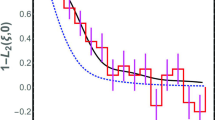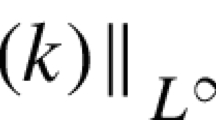Abstract
Recently, an Enskog-type kinetic theory for Vicsek-type models for self-propelled particles has been proposed [T. Ihle, Phys. Rev. E 83, 030901 (2011)]. This theory is based on an exact equation for a Markov chain in phase space and is not limited to small density. Previously, the hydrodynamic equations were derived from this theory and its transport coefficients were given in terms of infinite series. Here, I show that the transport coefficients take a simple form in the large density limit. This allows me to analytically evaluate the well-known density instability of the polarly ordered phase near the flocking threshold at moderate and large densities. The growth rate of a longitudinal perturbation is calculated and several scaling regimes, including three different power laws, are identified. It is shown that at large densities, the restabilization of the ordered phase at smaller noise is analytically accessible within the range of validity of the hydrodynamic theory. Analytical predictions for the width of the unstable band, the maximum growth rate, and for the wave number below which the instability occurs are given. In particular, the system size below which spatial perturbations of the homogeneous ordered state are stable is predicted to scale with where √M is the average number of collision partners. The typical time scale until the instability becomes visible is calculated and is proportional to M.
Similar content being viewed by others
References
T. Vicsek, A. Zafeiris, Phys. Rep. 517, 71 (2012)
S. Ramaswamy, Annu. Rev. Condens. Matter Phys. 1, 323 (2010)
M.C. Marchetti, et al., Rev. Mod. Phys. 85, 1143 (2013)
G. Rückner, R. Kapral, Phys. Rev. Lett. 98, 150603 (2007)
D. Humphrey, et al., Nature 416, 413 (2002)
M. Rubenstein, A. Cornejo, R. Nagpal, Science 345, 795 (2014)
S. Wilson, et al., Swarm Intell. 8, 303 (2014)
T. Vicsek, et al., Phys. Rev. Lett. 75, 1226 (1995)
A. Czirók, H.E. Stanley, T. Vicsek, J. Phys. A 30, 1375 (1997)
H. Levine, W.-J. Rappel, I. Cohen, Phys. Rev. E 63, 017101 (2000)
I.D. Couzin, et al., J. theor. Biol. 218, 1 (2002)
F. Thüroff, C.A. Weber, E. Frey, Phys. Rev. Lett. 111, 190601 (2013)
T. Hanke, C.A. Weber, E. Frey, Phys. Rev. E 88, 052309 (2013)
J. Toner, Y. Tu, Phys. Rev. E 58, 4828 (1998)
J. Toner, Phys. Rev. E 86, 031918 (2012)
K. Kruse, et al., Eur. Phys. J. E 16, 5 (2005)
I.S. Aranson, L.S. Tsimring, Phys. Rev. E 71, 050901 (2005)
T. Ihle, Phys. Rev. E 83, 030901 (2011)
T. Ihle, [arXiv:1006.1825v1] (old version of Ref. [18])
T. Ihle, Phys. Rev. E 88, 040303 (2013)
T. Ihle, Eur. Phys. J. Special Topics 223, 1293 (2014)
T. Ihle, Eur. Phys. J. Special Topics 223, 1423 (2014)
A. Peshkov, E. Bertin, F. Ginelli, H. Chaté, Eur. Phys. J. Special Topics 223, 1315 (2014)
T. Ihle, Eur. Phys. J. Special Topics 223, 1427 (2014)
E. Bertin, et al., Eur. Phys. J. Special Topics 223, 1419 (2014)
Y.-L. Chou, R. Wolfe, T. Ihle, Phys. Rev. E 86, 021120 (2012)
M. Romensky, V. Lobaskin, T. Ihle, Phys. Rev. E 90, 063315 (2014)
E. Bertin, M. Droz, G. Grégoire, Phys. Rev. E 74, 022101 (2006)
E. Bertin, M. Droz, G. Grégoire, J. Phys. A 42, 445001 (2009)
R. Großmann, L. Schimansky-Geier, P. Romanczuk, New J. Phys. 15, 085014 (2013)
M. Romenskyy, V. Lobaskin, Eur. Phys. J.B 86, 91 (2013)
G. Grégoire, H. Chaté, Phys. Rev. Lett. 92 025702 (2004)
H. Chaté, F. Ginelli, G. Grégoire, F. Raynaud, Phys. Rev. E 77 046113 (2008)
Y.L. Chou, T. Ihle, Phys. Rev. E 91, 022103 (2015)
T. Ihle, Phys. Chem. Chem. Phys. 11, 9667 (2009)
A. Peshkov, S. Ngo, E. Bertin, H. Chaté, F. Ginelli, Phys. Rev. Lett. 109, 098101 (2012)
S. Mishra, A. Baskaran, M.C. Marchetti, Phys. Rev. E 81, 061916 (2010)
A.M. Menzel, Phys. Rev. E 85, 021912 (2012)
P. Romanczuk, L. Schimansky-Geier, Ecol. Complex. 10, 83 (2012)
R.W. Tegeder, J. Krause, Philos. Trans. R. Soc. London B 350, 381 (1995)
M. Ballerini, et al., Proc. Natl. Acad. Sci. USA 105, 1232 (2008)
M. Ballerini, Anim. Behav., et al., Proc. Natl. Acad. Sci. USA 76, 201 (2008)
G. Baglietto, E.V. Albano, Phys. Rev. E 78, 021125 (2008)
G. Baglietto, E.V. Albano, Phys. Rev. E 80, 050103 (2009)
M. Nagy, I. Daruka, T. Vicsek, Physica A 373, 445 (2007)
T. Ihle (unpublished)
A. Peshkov, I.S. Aranson, E. Bertin, H. Chaté, F. Ginelli, Phys. Rev. Lett. 109, 268701 (2012)
In this context, “enslaved” means that the higher order coefficients are functionals of the lower Fourier coefficients g0,g1,h0,h1, and depend only indirectly on space and time through the temporal and spatial variations of these lower order coefficients
The critical noise ηC goes to 2π for M → ∞, [18]. η = 2π means that particle directions are completely randomized in every iteration, and all memory of previous orientations is destroyed: particles just perform independent random walks. Ring-kinetic theory [34] predicts that for η = 2π the common prefactor of the amplification factor for connected correlation functions becomes zero. Thus, even for η slightly smaller than 2π, correlations will be strongly damped
Note, that for M ≫ 1, the restriction to large mean free path is not a major restriction. It just leads to an easier evaluation of the transport coefficients but, in principle, can be removed by including the effects of collisional momentum transfer, as shown in Ref. [35]
Author information
Authors and Affiliations
Corresponding author
Rights and permissions
About this article
Cite this article
Ihle, T. Large density expansion of a hydrodynamic theory for self-propelled particles. Eur. Phys. J. Spec. Top. 224, 1303–1324 (2015). https://doi.org/10.1140/epjst/e2015-02461-4
Received:
Revised:
Published:
Issue Date:
DOI: https://doi.org/10.1140/epjst/e2015-02461-4




